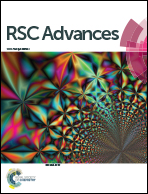Adsorption isotherms and mechanisms of Cu(ii) sorption onto TEMPO-mediated oxidized cellulose nanofibers†
Abstract
2,2,6,6-Tetramethyl-1-piperidinyloxy (TEMPO) mediated oxidized cellulose nanofibers (TOCNF) have shown potential in the removal of metal ions from contaminated water owing to their abundant carboxylate groups on their surface, functioning as metal sorption sites. The current work aims to study the kinetics and thermodynamics of the sorption behavior of Cu(II) onto TOCNF, and verify the correlation between Δ[H+] and the corresponding Δ[Cu(II)] in aqueous solution during sorption. Sorption of Cu(II) onto TOCNF was found to be an exothermic process with fast kinetics; reaching equilibrium Cu(II) adsorption in less than 1 min. The sorption data fits well with Langmuir isotherm models. The SEM imaging of the TOCNF after Cu(II) sorption revealed interesting copper-containing nanoparticles, which was further analyzed by using XRD. Besides, a linear correlation between Δ[H+] and the corresponding Δ[Cu(II)] in the solution was found, which indicates that the Cu(II) sorption capacity might be well predicted and calculated by Δ[H+] or pH variation during Cu(II) ion sorption onto TEMPO oxidized nanocellulose fibers and have potential to develop online sensors for tracking metal ion removal.


 Please wait while we load your content...
Please wait while we load your content...